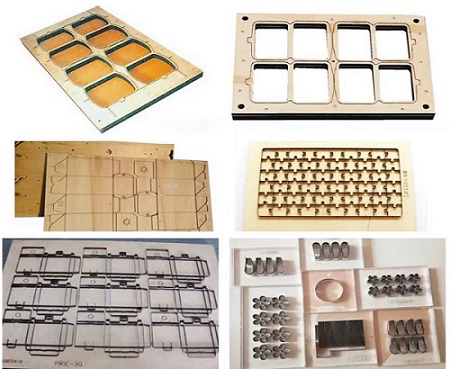Views: 0 Author: Site Editor Publish Time: 2022-04-02 Origin: Site

In the die-cutting industry, the die is an indispensable tool. The die is composed of a die-cutting plate and a blade. It is generally used for the shape of the product required for stamping. There are many types of blades used in the die! Today we share with you: how to choose a die according to the characteristics of the product. To sum up, the die should be selected from three aspects of the product, in order: product accuracy, product material material, product production volume!
Product accuracy
The error of the mold itself is between plus or minus 0.05~0.2MM!
1. If the product accuracy is within plus or minus 0.05, three types of paint molds can be used: corrosion mold, engraving mold, and hardware mold;
2. If the product accuracy is within plus or minus 0.1, then please use two types of molds: wood mold and plastic mold (of course, the other three types can also be used, but the cost is high).
If you can't relax product tolerances, then don't think about using low-cost molds!
The material of the product material
1. Ordinary cardboard Ordinary cardboard includes common cardboard, corrugated paper, etc. For die-cutting this type of cardboard, an ordinary laser die (52o blade angle) can be used. If the die-cutting shape is complex, it is necessary to use a die with a slightly lower blade hardness and better bending performance. In the die-cutting process, if the die-cutting pressure is required to be small, a die with a blade angle of 42o can be selected. Low die cutting pressure reduces edge wear and extends die cutting life
2. Rigid rubber sheet Rigid rubber sheet includes PVC, PET, electronic boards, high-density materials, gaskets, etc. Die-cutting such materials requires a die with high hardness. The hardness of the ordinary laser knife body is 39HRC, and the hardness of the blade is 57HRC. If you want to die-cut hard rubber, you need to choose a die with a blade hardness of 47HRC and a blade hardness of 59HRC. The smaller the blade angle, the higher the hardness of the blade, the better the wear resistance.
3. Flexible materials Flexible materials include aluminum foil, peritoneal material, soft plastic, etc. Die-cutting such materials requires the use of a die with a finely ground edge. This type of die has a smooth edge surface, requires low die-cutting pressure, can easily pass through viscous materials, and reduces the problem of cutting edge drawing and fluffing.
Examples of commonly used materials
At present, there are many materials for die-cutting, the most common ones are double-sided tape, PET, foam, etc...
Take double-sided tape as an example:
The material is soft and the precision is not high, so it is best to use the plastic plate mold, and the plastic plate mold is cheap;
If the precision is high, the corrosion mold is used, the mold cost is not high, and the product tolerance can be met;
Engraving molds can also be used, but the cost is higher;
Corrosion molds just don't have the stability and longevity of engraving molds.
Take PET as an example:
The material is hard, especially when the thickness reaches 0.188 or more, it is recommended to use more wood molds for PET above 0.188mm, and the thick knife of the bottom plate is not easy to expand.
The production volume of the product
Need to choose according to the life of the mold! If the product batch is large, the products that are easy to be stamped should use wooden molds and plastic molds as much as possible; if the products are of high precision and easy to be stamped, try to use corrosion molds; if the products are of high precision and cannot be discarded at one time, engraving molds or metal molds can be used to make them. Use to achieve integrated waste removal (because they can be modeled according to the angle you imagine);
If the product is complex, the QDC mold can be used for multiple processes, the positioning holes are convenient, and the dimensional accuracy of the product can also be guaranteed to be within plus or minus 5 wires.
Matters needing attention when choosing a die
1. After laminating with various materials, according to the thickness, hardness, and complexity of the product, the blade height of the high-peak knife and the short-peak knife, the wood mold and the plastic film is relatively high and easy to adjust. Generally in 2MM ~ 6MM.
The corrosion mold is generally 1MM~1.5MM;
The engraving mold is generally 1MM~2MM;
The metal mold is punched with a punch.
2. When choosing a knife die, attention should be paid to the horizontal grain treatment or straight grain treatment of the knife peak. The knife with horizontal grain treatment is better for die-cutting paper, more durable, less messy and more precise, and it is not easy to crack after being bent, while the surface of the knife with straight grain treatment seems to be very sharp, so it can be cut on the steel plate during die-cutting. On the surface, it is easy to become blunt in a short time. At the same time, it is easy to crack after being bent. Therefore, in addition to the use of straight-grained knife for die-cutting film products, it is better to use horizontal-grain processing for die-cutting paper products. Die cutter.
Sign up for our newsletter
Ms. Judy Liu
Cell: +86 134 2095 0731
Email: sales@tsdlaser.com
Address
Building H, Sha Si Hi-Tech Park, Shajing, Baoan District, Shenzhen
Service
Copyright © 2021 Shenzhen TSD Laser Equipment Co., Ltd | Supported by leadong.com | sitemap 粤ICP备12005242号-9
